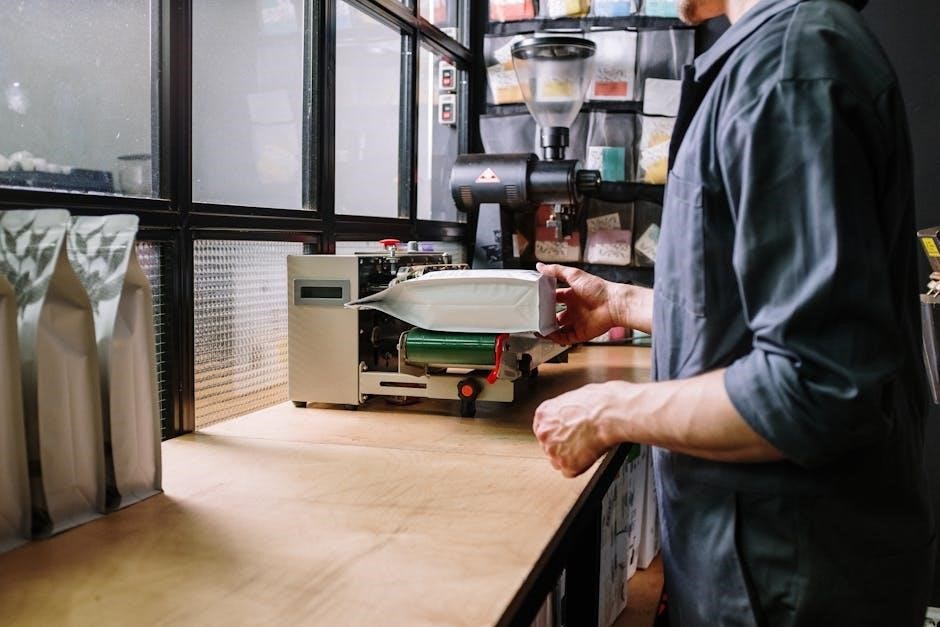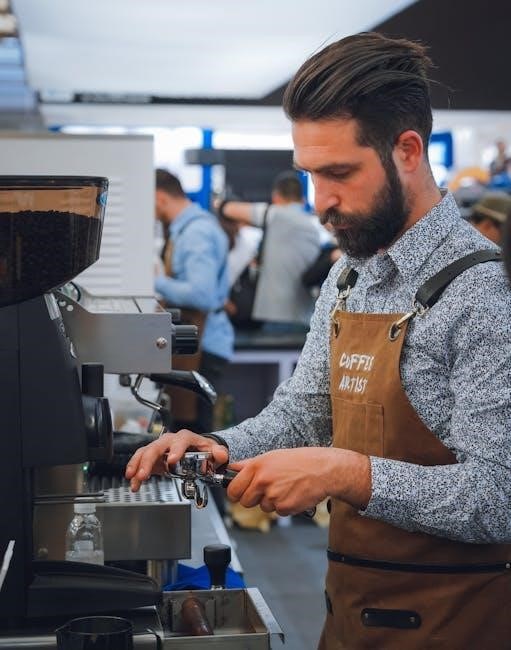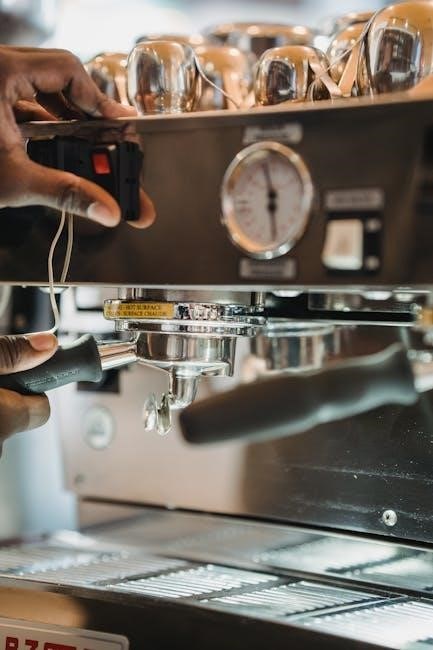The debate between automatic and manual coffee machines revolves around convenience, control, and coffee quality. This article explores their differences, helping you choose the perfect brewing companion.
Key Differences
Automatic coffee machines offer convenience and speed, while manual machines provide greater control over brewing parameters, catering to different preferences and coffee-making experiences.
Automation Level
Automatic coffee machines feature advanced automation, handling tasks like grinding beans, tamping, and brewing with minimal user intervention. They often include programmable settings for customization. Manual machines require hands-on involvement, allowing users to control every step, from measuring coffee to pouring water, offering a more tactile experience. The automation level significantly impacts the user experience, with automatic machines suiting busy individuals and manual machines appealing to coffee enthusiasts. The choice between them depends on whether convenience or control is a priority.
Coffee Quality
Coffee quality in automatic and manual machines can vary based on factors like precision, control, and user expertise. Automatic machines ensure consistency with precise temperature and extraction settings, though they may lack the nuanced control of manual brewing. Manual machines, such as pour-overs or espresso, allow for greater customization, enabling users to fine-tune parameters like water flow and coffee-to-water ratio. However, manual methods require skill and practice to achieve optimal results. Both types can produce high-quality coffee, but the best choice depends on the user’s preference for convenience versus hands-on craftsmanship. The quality ultimately reflects the balance between technology and human touch.
Pros and Cons
Automatic coffee machines offer convenience and consistency but may lack customization. Manual machines provide control over brewing but require effort and time. Both have unique trade-offs.
Automatic Coffee Machines
Automatic coffee machines are designed for ease of use, offering a range of features like programmable timers, multiple brewing options, and built-in grinders. They cater to those seeking convenience, as they automate grinding, tamping, and brewing processes. Many models allow customization of brew strength and cup size, while others include advanced features like milk frothing for cappuccinos and lattes. Despite their higher cost, these machines are ideal for busy individuals who value time and consistency. Maintenance is often straightforward, with removable parts and descaling alerts. However, they may lack the precision control that manual machines provide, making them less appealing to coffee enthusiasts who prioritize customization over convenience.
Manual Coffee Machines
Manual coffee machines are favored by coffee purists who enjoy the hands-on brewing process. These devices require users to perform tasks such as grinding beans, boiling water, and manually pouring over coffee grounds. The absence of automation allows for precise control over brewing parameters like water temperature, coffee-to-water ratio, and extraction time. This level of customization often results in a more nuanced and flavorful cup of coffee. However, manual machines are less convenient and require more time and effort, making them less suited for busy households. Despite this, they are typically more affordable and offer a satisfying, traditional coffee-making experience that many enthusiasts cherish.

Cost Considerations
The cost of coffee machines varies significantly between automatic and manual models. Automatic machines are generally more expensive due to their advanced features like grinding beans, brewing, and frothing milk. High-end automatic models with smart technology can range from $500 to $2,000. In contrast, manual machines are often more budget-friendly, with options starting as low as $20. Mid-range manual machines, such as pour-over or French press, typically cost between $50 to $150. However, while manual machines are cheaper upfront, automatic machines may save money in the long run by reducing waste and offering convenience. Additionally, automatic machines often come with extended warranties, which can be a cost-saving factor. Budget-conscious buyers may prefer manual machines, while those valuing convenience might invest in automatic ones.
Maintenance and Cleaning
Maintenance and cleaning requirements differ significantly between automatic and manual coffee machines; Automatic machines often have more complex components, such as milk frothers and grinders, which require regular cleaning to prevent clogging and bacterial growth. Descaling is also necessary to remove mineral buildup, ensuring optimal performance and flavor. Some high-end automatic models feature self-cleaning modes, simplifying upkeep. Manual machines, on the other hand, are generally easier to maintain due to their simpler design. Cleaning typically involves rinsing and occasional soap washing. However, manual machines lack automated features, so users must handle maintenance tasks themselves. Overall, automatic machines require more attention but offer convenience, while manual machines are low-maintenance and straightforward to care for. Regular upkeep is essential for both to ensure longevity and quality brewing.
Popular Models
Automatic favorites include the Philips 3200 series and De’Longhi Magnifica. Manual picks are the AeroPress, Chemex, and French press, each offering unique brewing experiences.
Automatic coffee machines offer unparalleled convenience, catering to those who prefer a hands-off brewing experience. They typically feature advanced automation, allowing users to preset brewing times, adjust strength, and even grind beans with built-in grinders. Many models, such as the Philips 3200 series, come with intuitive interfaces and programmable settings, making them ideal for busy individuals. These machines often include features like automatic frothing for lattes and cappuccinos, adding to their appeal. While they may require more initial investment and regular maintenance, automatic coffee machines deliver consistent results with minimal effort, making them a popular choice for coffee enthusiasts who value both quality and ease of use.
Manual coffee machines provide a traditional and tactile brewing experience, appealing to those who enjoy full control over their coffee-making process. These machines require users to manually operate various steps, such as tamping the coffee grounds, steaming milk, and brewing. This hands-on approach allows for precise customization of flavor and texture. Manual machines are often more affordable and easier to maintain than their automatic counterparts. They also tend to be more compact and durable, making them a great option for coffee purists or those with limited kitchen space. However, they demand more time and effort, as users must master techniques to achieve the best results. Despite this, manual machines remain popular among enthusiasts who value the artistry and personalization of coffee-making.

Customization and Control
Customization and control are crucial factors when choosing between automatic and manual coffee machines. Automatic machines often come with preset settings, allowing users to adjust basic parameters like coffee strength or cup size, but they lack the depth of customization offered by manual machines. Manual machines provide full control over brewing variables such as water temperature, coffee-to-water ratio, and extraction time, making them ideal for coffee enthusiasts who want to experiment and fine-tune their brews. However, this level of control requires skill and practice to master. Automatic machines, while less customizable, offer convenience and consistency for those who prefer a hassle-free experience. Ultimately, the choice depends on whether you value precision and personalization or ease of use.
Brewing Speed
Brewing speed is a key consideration when comparing automatic and manual coffee machines. Automatic machines are generally faster, as they automate the grinding, tamping, and brewing processes, allowing users to produce coffee with minimal effort and time. Many automatic models can brew a cup in under a minute, making them ideal for busy individuals. Manual machines, on the other hand, require more time and effort, as users must manually grind beans, heat water, and control the brewing process. This slower pace can be a drawback for those seeking convenience but is often preferred by coffee purists who value the hands-on experience. The choice between speed and manual craftsmanship depends on personal priorities and lifestyle.

User Experience
User experience differs significantly between automatic and manual coffee machines. Automatic machines are designed for simplicity and convenience, often featuring user-friendly interfaces with preset options for different coffee drinks. This makes them accessible to novices and those who want a quick, hassle-free brewing process. Manual machines, while more complex, offer a tactile experience that appeals to coffee enthusiasts. They require a deeper understanding of brewing techniques, which can be rewarding for those willing to invest the time and effort. The choice between the two ultimately depends on whether the user prioritizes ease of use or enjoys the hands-on, customizable process of manual brewing. Each type caters to distinct preferences, shaping the overall user experience.

Environmental Impact
The environmental impact of automatic and manual coffee machines varies significantly. Automatic machines often consume more energy and may rely on single-use capsules, contributing to higher waste levels. Manual machines, such as French presses or pour-overs, typically use less energy and generate minimal waste, making them more eco-friendly. Additionally, manual brewing methods avoid the environmental footprint associated with capsule production and disposal. However, the overall sustainability also depends on the machine’s material, longevity, and maintenance. Choosing a manual coffee machine usually aligns better with environmentally conscious choices due to lower energy consumption and reduced waste generation.
The choice between automatic and manual coffee machines ultimately depends on personal preferences, lifestyle, and priorities. Automatic machines offer convenience and speed, ideal for busy individuals, while manual machines provide greater control and a more traditional brewing experience. Factors like coffee quality, cost, maintenance, and environmental impact should also be considered. For those who value ease of use and consistency, automatic machines are a great option. However, for coffee enthusiasts who enjoy the process and want a more eco-friendly choice, manual machines are often the preferred choice. Both options can deliver excellent results, making it important to weigh these aspects carefully to find the perfect fit for your daily coffee routine.